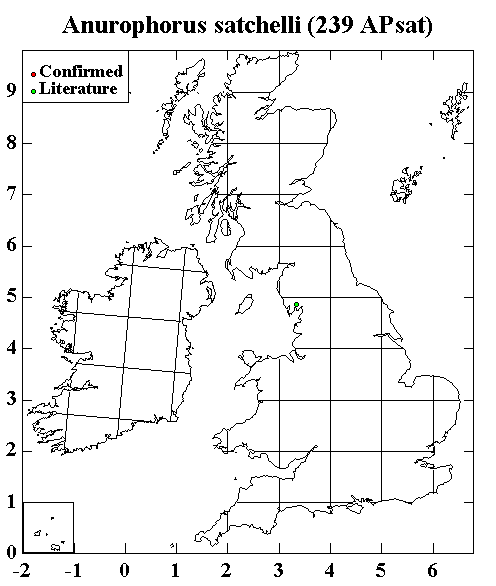|
Anurophorus satchelli was described by Goto (1956) from specimens extracted by Tullgren funnel by J.E. Satchell from White Moss near Grange-over-Sands in December 1953. The precise habitat was described as Molinia tussocks rising about 50 cm above the wet peat. Anurophorus satchelli is superficially similar to Anurophorus laricis but it possesses 6+6 ocelli in the eyes (cf. 8+8 in Anurophorus laricis) and an empodial appendage which reaches about 0.3 times the length of the claw on the foot of the first and second pair of legs, and 0.5 times the length of the claw on the third pair of legs (cf. empodial appendage absent in Anurophorus laricis). Like Anurophorus laricis, the tibiotarsi of Anurophorus satchelli possess several clavate tenant setae (in Bagnall's description of Anurophorus unguiculus, he reported that knobbed setae were absent, but see below). Anurophorus satchelli at 0.7 mm is also much smaller than Anurophorus laricis.
Goto placed the holotype of Anurophorus satchelli in the NHML slide collection but this appears to have been lost. The above description is based on Goto's (1956) paper.
Recently, Misha Potapov has examined the holotype and other specimens of Anurophorus unguiculus and has come to the conclusion that it is probably a senior synonym of Anurophorus satchelli. In contrast to Bagnall's description of Anurophorus unguiculus, there ARE slightly knobbed setae on the tibiotarsi. It is not possible to see the number of ocelli but the lengths of empodial appendages on the feet are identical to the description of Anurophorus satchelli.
Thus, it is almost certain that Anurophorus satchelli will be sunk as a junior synonym of Anurophorus unguiculus.
Back to main page
|
|

